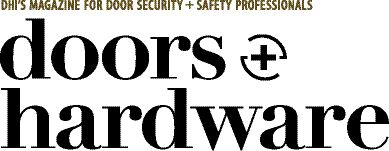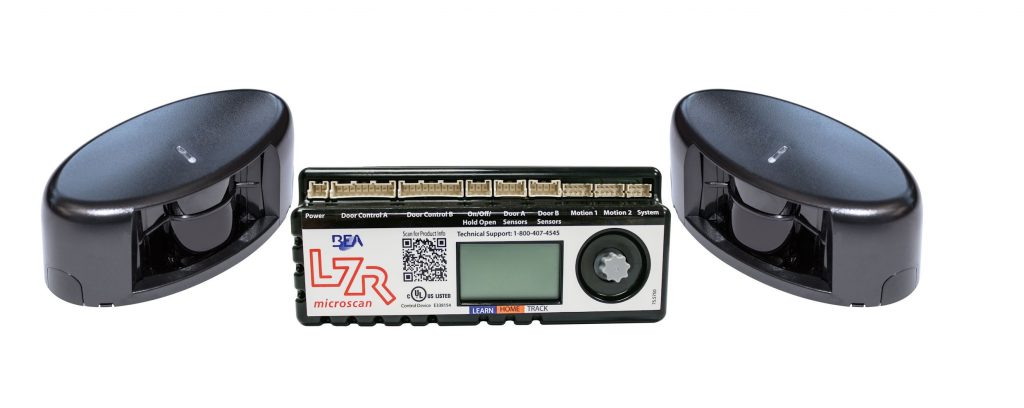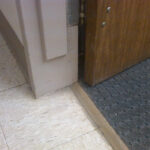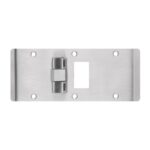This post was published in D.lllloors & Hardware
.

 For doors with automatic operators, there are two standards that are referenced by the model codes. Low-energy and power-assist operators must comply with BHMA A156.19, and power-operated pedestrian doors must comply with BHMA A156.10. Low-energy operators are typically found on doors that are operated by an actuator mounted on the wall, or some other type of knowing act. Power-assist doors open manually with reduced opening force. Power-operated pedestrian doors are swinging, sliding, or folding doors which usually open automatically when a motion sensor detects an approaching occupant.
For doors with automatic operators, there are two standards that are referenced by the model codes. Low-energy and power-assist operators must comply with BHMA A156.19, and power-operated pedestrian doors must comply with BHMA A156.10. Low-energy operators are typically found on doors that are operated by an actuator mounted on the wall, or some other type of knowing act. Power-assist doors open manually with reduced opening force. Power-operated pedestrian doors are swinging, sliding, or folding doors which usually open automatically when a motion sensor detects an approaching occupant.
The edition of A156.10 – Standard for Power-Operated Pedestrian Doors published in 2017 included an important change with regard to the presence sensors and safety control mats that are required to prevent a door from opening or closing automatically if the surrounding area is not clear. This change also applies to low-energy operators that are actuated by a motion sensor, because A156.19 requires these doors to comply with A156.10 when the operator is not initiated by a knowing act. The intent of the newly-added requirement for monitoring is to decrease the possibility of injury or entrapment caused by automatic doors with missing, disabled, disconnected, or defective safety sensors and safety control mats.
The safety sensor requirements, found in Sections 7.6.1 and 8.1.4 of the A156.10 standard, require power-operated pedestrian door systems to include a means to verify that the presence sensors are functional, and that there is communication between the automatic door control system and each presence sensor. If a fault is detected, the automatic operator cannot function until the fault is corrected. Monitoring of the presence sensors must occur at least once before each closing cycle, but some systems also monitor the sensors before each opening cycle as well.
The technology used in monitored safety sensors was fairly new when A156.10 was last updated in 2011, but the capability of monitoring sensors has now been available for several years. It has not been a standard feature for most automatic-door systems, but going forward it will be mandatory for presence sensors on automatic doors that are required to comply with the 2017 edition of A156.10. Existing doors are not necessarily required to comply with the monitoring requirements, depending on the codes and standards that have been adopted in the jurisdiction where the facility is located. However, upgrading existing doors may lead to decreased incidents involving malfunctioning or disconnected sensors and door controls.
 Most low-energy power operators are actuated by using a “knowing act” as required by BHMA A156.19 – Standard for Power Assist and Low Energy Power Operated Doors (2007 edition and subsequent editions). A knowing act is a conscious action to initiate the powered opening of the door, and includes push buttons, fixed non-contact switches (touchless switches with a range of 12 inches or less), access-control readers, or pushing or pulling the door. Low-energy power operators initiated by a knowing act do not require presence sensors and are not directly affected by the new monitoring requirements.
Most low-energy power operators are actuated by using a “knowing act” as required by BHMA A156.19 – Standard for Power Assist and Low Energy Power Operated Doors (2007 edition and subsequent editions). A knowing act is a conscious action to initiate the powered opening of the door, and includes push buttons, fixed non-contact switches (touchless switches with a range of 12 inches or less), access-control readers, or pushing or pulling the door. Low-energy power operators initiated by a knowing act do not require presence sensors and are not directly affected by the new monitoring requirements.
When a door with a low-energy power operator is initiated by a motion sensor instead of by a knowing act, the door must comply with the requirements of BHMA A156.10, which includes the addition of presence sensors or safety control mats, and in most cases, guide rails. Therefore, low-energy power operators that are not initiated by a knowing act must have monitored presence sensors or monitored safety control mats as required by the 2017 edition of BHMA A156.10.
When automatic operators are installed on fire door assemblies, the operators must be listed to UL 10C – Standard for Positive Pressure Fire Tests of Door Assemblies or NFPA 252 – Standard Methods of Fire Tests of Door Assemblies. These tests ensure that the products are safe for use on fire-rated doors, and accessories – including sensors – are also required to be tested and listed to one of these test standards. In addition, NFPA 80 – Standard for Fire Doors and Other Opening Protectives, requires power-operated fire doors to be equipped with a releasing device that will automatically disconnect the operator at the time of a fire, allowing a self-closing or automatic device to close and latch the door.
Typically, a new standard goes into effect when it is incorporated into a model code by reference, and that code is adopted by a jurisdiction. However, the effective date for the changes incorporated into the 2017 edition of A156.10 was November 11, 2017, 90 days after the publication of the standard. The impact of the monitoring change on existing installations is addressed in Appendix E, Section E-6, which was added to the 2017 edition.
Additional revisions to the 2017 edition of BHMA A156.10 include a definition for the term “monitoring fault” and a change in the required location of automatic-door signage to 50 inches +/- 12 inches from the floor to the center line of the sign (previously 58 inches +/- 5 inches). Drawings in Appendix A were updated, and grammatical changes were made throughout the document.
The American Association of Automatic Door Manufacturers (AAADM) strongly recommends daily safety checks of all automatic doors, conducted by the owner or person responsible for the equipment. These checks include verification that the activating and safety sensors or mats are working properly, the doors open and close without impact, the doors, threshold, and guide rails are intact and properly secured, proper safety signage is present, and the area is free of obstacles that could affect the traffic flow or operation of the doors. If any deficiencies are found during the safety check, the doors should be safely secured and serviced immediately; automatic doors should be installed, serviced, and inspected at least annually by an AAADM-certified technician. In addition, AAADM mandates that installation and service technicians who are AAADM certified are required to conduct a safety check during each installation or service call.
For more information about automatic-door safety and the standards that apply to automatic doors, visit BHMA’s website at www.buildershardware.com, or AAADM’s website at www.aaadm.com.
~~~
Many thanks to Jeff Dunham of BEA Sensors for his assistance with the background information needed for this article. BEA has successfully tested a safety sensor that is capable of internal and external monitoring in compliance with A156.10, and the product is listed to UL 10C for use on a fire door assembly (the 10LZRMICROSCAN1UT-FR is available as of December 5th, 2017) .
You need to login or register to bookmark/favorite this content.







Operators that function by a knowing act:
– Is fire alarm interface required if the operator is controlling a fire/smoke door?
Hi Alex –
Yes – NFPA 80 says:
6.1.3.4 Power-Operated Fire Doors. Power-operated fire doors shall be equipped with a releasing device that shall automatically disconnect the power operator at the time of fire, allowing a self-closing or automatic device to close and latch the door regardless of power failure or manual operation.
– Lori
Wat is the best sensor activation option available for swing doors if we take into account the applicability of activation sensors in the swing region of the door leaf.
I am in the process of specifying your 9542 low energy AO. What do I do?
Hi Al –
What kind of help do you need?
– Lori
What additional hardware do I need to specify?
If the operator will be actuated by a knowing act (like push-button actuators), you don’t need to specify anything different. If the operator will be actuated by a sensor, then you need one of the following kits from LCN:
8310-3882 – Monitored Safety Sensor Kit for Double Door Applications (Includes Header Mount Activation Sensor)
8310-3881 – Monitored Safety Sensor Kit for Single Door Applications (Includes Header Mount Activation Sensor)
8310-879 – Monitored Safety Sensor Kit for Double Door Applications
8310-878 – Monitored Safety Sensor Kit for Single Door Applications
– Lori